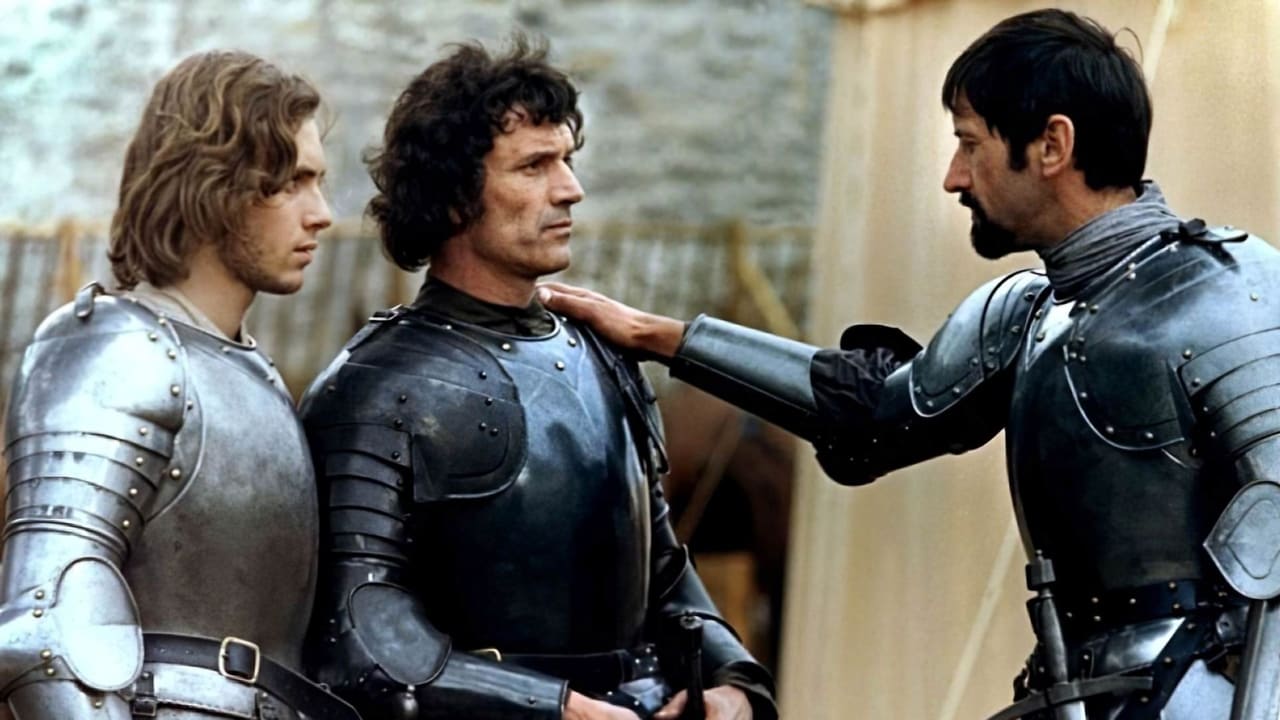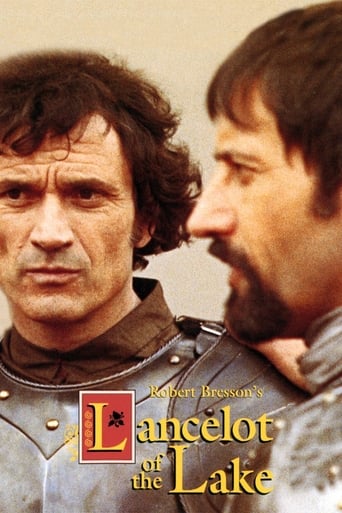

Too much of everything
... View MoreA Surprisingly Unforgettable Movie!
... View MoreThe first must-see film of the year.
... View MoreThe film's masterful storytelling did its job. The message was clear. No need to overdo.
... View MoreWith "Lancelot of the Lake", director Robert Bresson takes the Arthurian legends – specifically Lancelot's affair with King Arthur's Queen, Guinevere – and removes the regality, romanticism, resplendence and reverence. What remains is perhaps the director's bleakest film, one in which cold blooded knights do petty and vile things to petty and vile people for petty and vile reasons."Lord, do not forsake me," Lancelot says before a crucifix. Significantly, Bresson's camera leaves the crucifix out of focus, for these knights spend the film focusing on themselves. They are the lords of these lands and God is a blur, men doing evil in Christ's name purely for their own selfish ends."It was not the Grail," Guinevere tells Lancelot, "it was God you all wanted!" But Lancelot doesn't listen. Bresson undercuts the self-importance, myopia and narcissism of his knights with scenes which stress how pathetic they truly are. Far from magnificent, their armour is clunky, ridiculous, and serves only as a reminder of how much they fear their own corporeality. And when they're not strutting about like clowns, Bresson spends time stressing how reliant on servants and peasants the knights have become. Scenes in which their feet are helped into stirrups by peasants and brief shots of the sad eyes and hooves of horses also recall Bresson's own "Au Hasard Balthazar", in which a donkey was forced to live its entire life in terror and misery. The knights induce and live in the same fear.As the film progresses, a kind of humble Christianity becomes increasingly perverted. The knights themselves are less concerned about spiritual matters than they are with competitive games (jousting, chess, duels, winning the favour of Kings and Queen), everyone looking to steal, and bask in, a little divine light.By the film's end, religion disappears entirely, an apocalyptic battle seemingly purging all the knights from the land. Always unconventional, Bresson stages the battle with a series of pans and medium shots. What violence is shown simply takes the form of wooden arrows being fired into the air and embedding themselves, not in armour and flesh, but the trunks of trees. We recall the blunt shots of falling trees in Bresson's "The Devil Probably". In "Lancelot", man too seems to have taken God's Eden and turned it evil, or perhaps destroyed it irrevocably. Last shot: corpses. Last word: "Guinevere". Even in death, Lancelot has nothing but desire and temptation on his lips.8/10 – Though interesting, this is but a smaller, and inferior, version of both Jancso's "The Red And The White" and Kurosawa's "Ran". The film needs at least two viewings to fully soak up Bresson nuances.
... View More**** (out of four) By Aaron Dumont Despite what you've heard, Lancelot du Lac remains one fo the most meditational, multi-faceted and cinematic movies ever made; this bare-bones, minimalist interpretation of the legend of Arthur, a late-period Bresson film that teeters dangerously between 'gorgeous' and 'tedious', is a stark, modernist beauty, a masterfully-structured transformation of the Arthurian legend and all its absurdities, its ridiculous blemishes, its lack of insight and apathy, and possibly all the other countless, pompously glamorous counterparts and adaptations--mostly cinematic--of the legend, as well.From the opening scene to the closing shot, Lancelot du Lac purposefully closes out all "emotions" (aka overacting and overposing) and any "enchanting" (read: astonishingly depthless and distracting) features of the original while calmly, serenely gliding through the anonymity of death--however, though seemingly of work of pessimism, Lancelot du Lac is as far from; it incorporates not only the agonies and facelessness of war, it succeeds in its transcendent, near-reverential attempt to give a reason to all the coldness and brutality--the camera moves along with phantom-like eyes of disillusionment and of loving craft, yet still remains almost purely physical, savage and kinetic much of the time. While most movies would simply remain boring as hell right from Step 1, Bresson, knowing an actual thing or two about cinema, meticulously emphasizes the texture, shape and form of the movie, creating a sprawling canvas of transmuted life, space, and humanity, while still reserving bridges and swirls of poetry and liberation.Bresson was indeed a skilled craftsman of the cinematic form. And, much like the rest of his oeuvre, he claws past every little insignificant bit and plot piece that are oh-so-conveniently (and, of course, conventionally) used, and goes straight for the most basic, most shamefully true, most resonant instincts; compulsion, meaningless bloodshed and the need to stay alive. Bresson never compromised; every one of his movies need devoted, undivided detention to grab hold of. And, he manages to sustain a movie with that (and an incredible one, too)--which should at least be respected, considering how that shouldn't even be possible in cinema.Though of course, Lancelot du Lac is difficult, to say the least--a fantasy without fantasy, a spectacular tale told in the mode of guilt and sensitivity. However, that's also what makes it so stunning--it is the work of someone who has given up on the petty, masturbatory pizazz of film-making, and of a genuine, fully-bloomed artist in their prime.
... View MoreIn Robert Bresson's short filmography, "Lancelot Du Lac" is probably his most dismissed piece of work for evident reasons. The author of such pearls like "Journal d'Un Curé De Campagne" (1951) and "au Hasard Balthazar" (1966) chose to adapt his minimal, inimitable style to the fabled tale of the Knights of the Round Table with Lancelot's adulterous love for the Queen Guenièvre. Was it an appropriated choice for a topic whose treatment inevitably required greatness, heroism, violence pertaining to a chivalrous tale?Well, viewers who aren't familiar with Bresson's genuine cinematographic approach won't approve of it with a basically epic story and the filmmaker seemed aware of it given his cinema is everything but spectacular. But the auteur pushed his ideas to the extreme. So, we have here an austere view of a story usually full of greatness with very little action. The film opens and ends after a fight with bodies falling down, horses running and a desolate battle ground in the heart of a deep green forest. In the middle of the film, the audience will be allowed to watch a tournament which Bresson will reduce to its simplest elements with flags waving, Gauvain and Arthur's looks, shots on some of the horsemen's characteristics like their horses' legs or their armors. Once again as in many Bresson's works, ellipses are given priority. When the two adversaries collide, one can't properly see the action but just the before and after.Between these rare, fragmented action sequences, the rest is devoted to an aging Lancelot and his relationships with Queen Guenièvre, King Arthur, Gauvain and the other knights. Proud characters have given way to weary ones. The Quest for the Holy Grail was lost and Lancelot attributes this defeat to the guilty love he has for Guenièvre. And he is torn between this serious mistake and the chivalrous demeanor he should adopt for Arthur. Gauvain is stuck in a similar situation between his respect for Lancelot and Arthur with whom he wants to remain faithful. Like in other Bresson works, redemption has a sizable role. Towards the end of the film, Lancelot wants to redeem himself by fighting with Arthur against Mordred. Animals also seem to play a small but vital role. A magpie is often on the branch of a tree facing the Queen's bedroom.It's no wonder this dry overhaul of the Knights of the Round Table baffled many viewers, especially the ones who have never heard of Bresson. Lines full of bitterness, regret or suspicion are recited by models with a monotonous voice and a stone-cold acting lead a film mostly deprived of action and violence. That's why I would only recommend it to Bresson's die-hard aficionados and not for newcomers who will be better served with John Boorman's "Excalibur" (1981).
... View MoreNot only is this a bad film, in every sense of the word - mostly because Bresson lets his film "dogma" overrun, as usual, common sense and just plain "watchability", but it also gives rise to two frequent misunderstandings which really irk me. First of all, Bresson was never part of the New Wave. Very few film-makers were. He was there before the New Wave, making decent, classic, perfectly structured and acted films like "Les Dames du Bois de Boulogne", with lots of help from original geniuses like Jean Cocteau, and was still there after the New Wave, experimenting with making increasingly more boring films for a coterie of film-school enthusiasts which must have numbered half a dozen people at its peak.Second misunderstanding: The story related in this "film" is not by Chrétien de Troyes. Although Chrétien was the first novelist to mention the knights of the Round Table, his stories never included the death of Arthur, although he did brush on Guinevere's infidelity and the legend of the Grail in books that inspired everything that followed, in French and English. So the credit should say: based on XIIIth century French prose continuations of the original poems by Chrétien de Troyes, which are found in what is collectively known to scholars as the anonymous and extremely varied Corpus Lancelot-Graal, a.k.a. as the Lancelot-Graal Cycle or, more simply, the Prose Lancelot. Are we clear on this? Thanks.
... View More